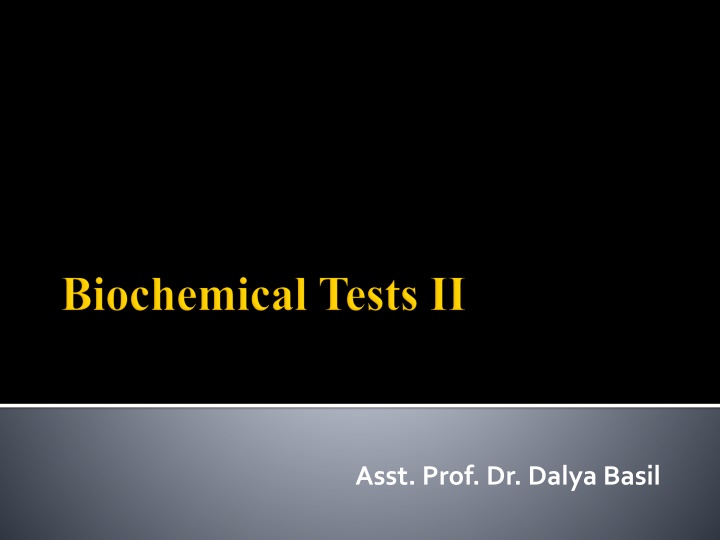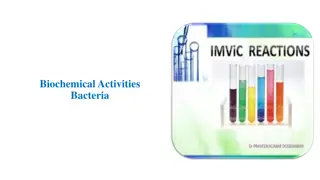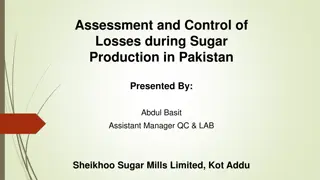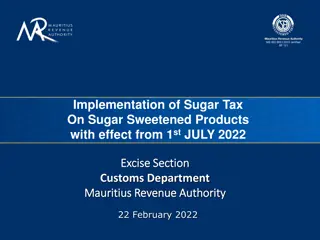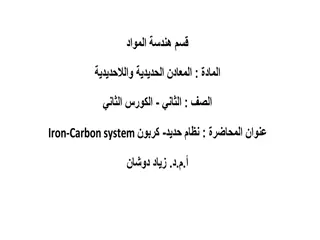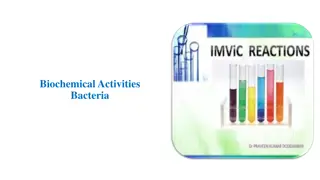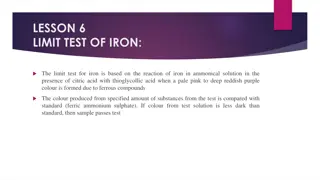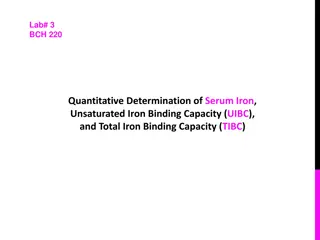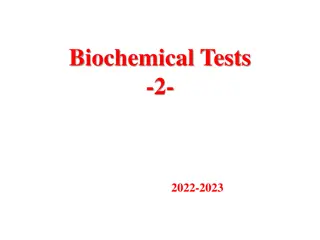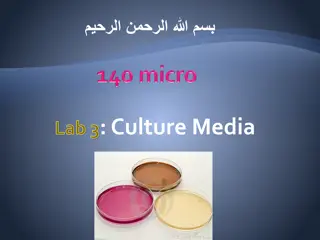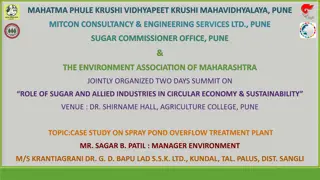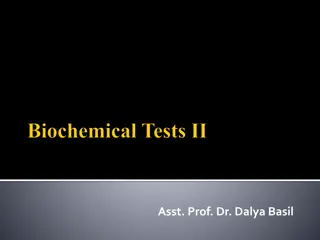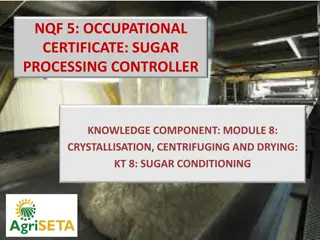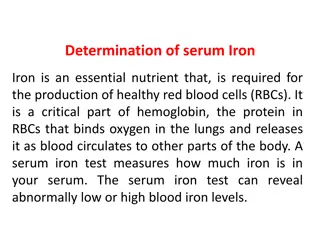Triple Sugar Iron Agar (TSI Agar) Test
Triple Sugar Iron Agar (TSI Agar) is a differential media used for identifying gram-negative enteric bacilli based on carbohydrate fermentation and hydrogen sulfide production. It helps detect carbohydrate fermentation, gas production, acidification, and H2S formation, providing valuable information for bacterial identification in microbiology laboratories.
Download Presentation

Please find below an Image/Link to download the presentation.
The content on the website is provided AS IS for your information and personal use only. It may not be sold, licensed, or shared on other websites without obtaining consent from the author.If you encounter any issues during the download, it is possible that the publisher has removed the file from their server.
You are allowed to download the files provided on this website for personal or commercial use, subject to the condition that they are used lawfully. All files are the property of their respective owners.
The content on the website is provided AS IS for your information and personal use only. It may not be sold, licensed, or shared on other websites without obtaining consent from the author.
E N D
Presentation Transcript
Triple Sugar Iron Test IndoleTest UreaseTest Simmons Citrate Test
Triple Sugar Iron Agar (TSI Agar) is used for the differentiation of gram-negative enteric bacilli based on carbohydrate fermentation and the production of hydrogensulfide.
Carbohydrate fermentation is detected by the presence of gas and a visible color change (from red to yellow) of the pH indicator, phenol red. The production of hydrogen sulfide is indicated by the presence of a precipitate that blackens the medium in the buttomof thetube.
0.1% Glucose: If only glucose is fermented, only enough acid is produced to turn the buttom yellow. The slant will remain red 1.0 % lactose/1.0% sucrose: a large amount of acid turns both buttom and slant yellow, thus indicating the ability of theculture to ferment eitherlactose or sucrose. Iron & sulfur: Ferrous sulfate: Indicator of H2Sformation Phenol red: Indicator of acidification (It is yellow in acidic condition andred underalkalineconditions). It also contains Peptone which acts as source of nitrogen. (when peptone is utilized under aerobic condition ammonia is produced)
With a sterilized straight inoculation needle touchthetop of awell-isolatedcolony Inoculate TSI Agar by first stabbing through thecenterofthemediumto thebottom ofthetubeand thenstreaking on the surface oftheagarslant.Incubate thetubeat37 C for18to 24hours.
If lactose (or sucrose) is fermented, a large amount of acid is produced, which turns the phenol red indicator yellow both in buttom and in the slant. Some organisms generate gases, which producesbubbles/cracks on themedium. If neither lactose/sucrose nor glucose is fermented, both the butt and the slant will be red. The slant can become a deeper red-purple (more alkaline) as a result of production of ammonia from the oxidative deamination of amino acids (peoptone).
If the sulfur compound is reduced, hydrogen sulfide will form and interact with the iron compound to form a black precipitate, which is especially visible in the butt (the black color offerrous sulfideisseen). If nothing happens (no change) the medium willstay orange.
Name of the organisms Slant Butt Gas H2S Escherichia, Klebsiella, Enterobacter Acid (A) Acid (A) Pos (+) Neg (-) Shigella, Serratia Alkaline (K) Acid (A) Neg (-) Neg (- ) Salmonella, Proteus Alkaline (K) Acid (A) Pos (+) Pos (+) Pseudomonas Alkaline (K) Alkaline (K) Neg (-) Neg (-)
This test demonstrate the ability of certain bacteria to decompose the amino acid tryptophan whichaccumulatesinthemedium. Indole production test is important in the identification of Enterobacteria. Most strains of E. coli, P. vulgaris, and Providencia species break down the amino acid tryptophan with thereleaseof indole. to indole,
This is performed by a chain of a number of different intracellular enzymes, a system generallyreferredtoastryptophanase. Tryptophanisanaminoacidthat can undergo deamination and hydrolysis by bacteria that expresstryptophanaseenzyme.
When indole is combined with Kovacs Reagent (which contains hydrochloric acid and p-dimethylaminobenzaldehyde in amyl alcohol) the solution turns from yellow to cherry red. Because amyl alcohol is not water soluble, the red coloration will form in an oily layer at the top of the broth.
Take a sterilized test tubes containing 4 ml of tryptophanbroth. Inoculate the tube aseptically by taking the growthfrom18to 24hrsculture. Incubatethetubeat37 C for24-28hours. Add 0.5 ml of Kovac s reagent to the broth culture. Observeforthepresenceor absenceofring.
Positive: Formation of a pink to red color ( cherry-red ring ) in the reagent layer on top of the medium within seconds of adding the reagent. Examples: Escherichia influenzae, Proteus sp. (not P. mirabilis and P. penneri), Aeromonas punctata, Bacillus alvei, shigelloides, Pasteurella multocida, Pasteurella Enterococcusfaecalis,and Vibriosp. coli, Haemophilus hydrophila, Aeromonas pneumotropica,
Negative: No color change even after the addition of appropriate Examples: Klebsiella Pasteurella haemolytica, Pasteurella ureae, Proteus mirabilis, sp.,Salmonella sp., Serratia sp., Yersinia sp., Actinobacillus spp., Aeromonas salmonicida, most Bacillus sp., Bordetella sp., Enterobacter sp., Lactobacillusspp.,most Haemophilussp. reagent. sp., Neisseria sp., Pseudomonas
The urease test is used to determine the ability of an organism to split urea, through the production of the enzyme urease and for the differentiation of entericbacilli.
Urea is the product of decarboxylation of amino acids. Hydrolysis of urea produces ammonia and CO2. The formation of ammonia alkalinizes the medium, and the pH shift is detectedby the color change of phenol red from light orange at pH6.8 topink at pH8.1. Rapid urease-positive organisms turn the entire medium pink within 24hours. Weakly positive organisms may take several days, and negative organisms produce no color change oryellowas a result ofacid production.
This test is used to differentiate organisms based on their ability to hydrolyze urea withthe enzyme urease. This test can be used as part of the identification of several genera and species of Enterobacteriaceae, including Proteus, Klebsiella, and Citrobacter species, Corynebacterium species. some well Yersinia as and some as It is also useful to identify Cryptococcus spp., Brucella, Helicobacter pylori, and many other bacteria that produce the urease enzyme. Directly, this test is performed on gastric biopsy samples to detect the presence of H. pylori.
The rapid urease test (RUT) is a popular diagnostic test for diagnosis of Helicobacter pylori. It is a rapid, cheap and simple test that detects the presence of urease in or on the gastric mucosa. It is also known as the CLO test (Campylobacter-like organism test). This test uses a gastric endoscopy and biopsy to collectstomachliningcells.
Simmons' differentiating gram-negative bacteria on the basisofcitrateutilization. citrate test is used for Simmons' agar citrate is a defined, selective and differential medium that tests for an organism's ability to use citrate as a sole carbon source and ammonium ions as the solenitrogensource.
The medium contains citrate, ammonium ions, and other inorganic ions needed for growth. It also contains bromothymol blue, a pH indicator. Bromothymol blue is green at pH below 6.9, and then turns blue at a pH of 7.6 or greater.
Inoculate simmons citrate agar lightly on the slant by touching the tip of a needle to a colonythatis18to 24hours old. Incubate at 37oC for 18 to 24 hours. Some organisms may require up to 7 days of incubation due to their limited rate of growth oncitratemedium. Observe the development of blue color; denotingalkalinization.
Citrate positive: growth will be visible on the slant surface and the medium color will change to blue. The alkaline bicarbonates produced as by-products of citrate catabolism raise the pH of the medium to above 7.6, causing the bromothymol blue to change fromtheoriginal greencolor toblue . Klebsiella pneumoniae, Enterobacter species and Salmonella other than Typhi and Paratyphi A are citratepositive. carbonates and
Citrate negative: trace or no growth will be visible. No color change will occur; the medium will remain the deep forest green color of the uninoculated agar. Only bacteria that can utilize citrate as the sole carbon and energy source will be able to grow on the Simmons citrate medium, thus a citrate-negative test culture will be virtually indistinguishable uninoculated slant. Escherichia coli, Shigella spp, Salmonella Typhi, and Salmonella ParatyphiA from an
